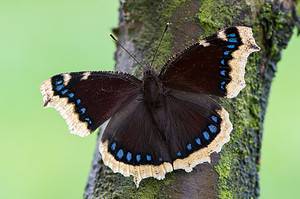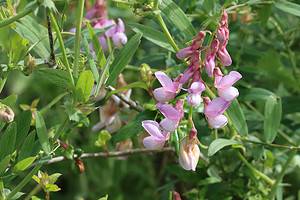Florida boasts a subtropical climate and enjoys over 200 days of sunshine every year. It’s no wonder many have chosen to call this state home or why hundreds of millions make this their ultimate vacation destination. The weather offers a wonderful respite from icy cold states, allowing sweaters, scarves, and coats to be traded for tank tops, bathing suits, and sandals. Along with the warm, humid weather, those who visit Florida can also enjoy the fluttering butterflies that also call this state home. Some are brightly colored while others have wings that help them camouflage well. Below, we explore ten butterfly species that you can spot throughout the sunshine state!
10 Butterflies That Live in Florida
1. Red Admiral
Scientific Name: Vanessa atalanta
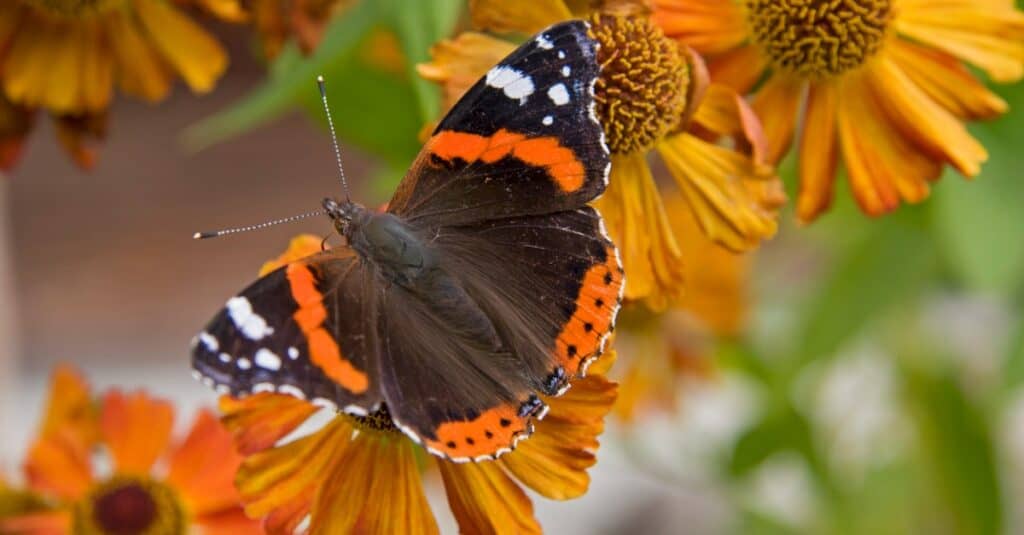
The
Vanessa atalanta, also known as the red admiral, can be found in Florida and many other parts of North America.
©iStock.com/Tinieder
Red admiral butterflies are medium-sized with distinctive black and orange colors along with spots of white. Along with Florida and other parts of North America (including Canada), this butterfly is also found in Europe, Eurasia, and the northern part of Africa. When they reach the adult form, red admirals have a wingspan of up to 2.5 inches. Although their hind wings are black and orange, the underside is a different array of colors. They’re more muted with dark colors and white spots. There’s a muted band as well that can be described as light pinkish to orange. Beneath the hind wings, they have a marbled appearance that adds a gorgeous complexity to the overall mesmerizing appearance of the red admiral.
2. Pipevine Swallowtail
Scientific Name: Battus philenor

The pipevine swallowtail is one of the most poisonous butterflies in existence and inhabits Florida and parts of Mexico.
©iStock.com/OGphoto
The pipevine swallowtail butterfly is one of the top butterflies that live in Florida. It is distinguished by its iridescent blue-green or blue color on its upper wings. The underside of the hindwing is decorated with several orange spots, beautifully contrasting the bluish, metallic coloration. These butterflies inhabit Florida along with other parts of the southern United States, dipping down into regions of Mexico as well. They prefer warm environments, particularly around meadows and woodlands. You can often spot them around lush gardens and nurseries. Aside from the iridescent and orange pops of color, the forewing of adult pipevine swallowtails is more of a deep black color with some gray just below. The males are different in appearance than the females, with brighter blues and smaller spots on their wings. Pipevine swallowtails are also poisonous butterflies.
3. Sleepy Orange
Scientific Name: Eurema nicippe
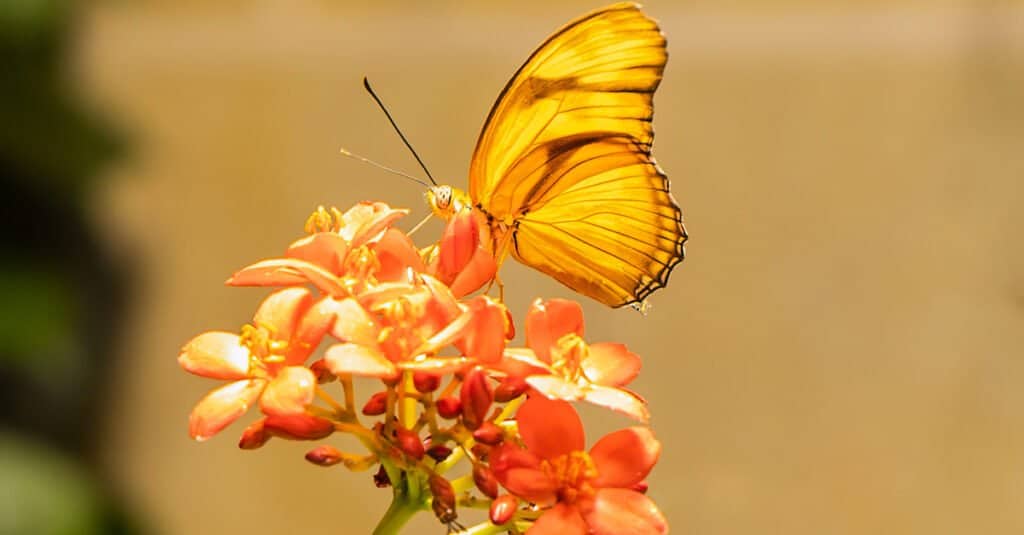
Sleep orange butterflies are brightly colored and can be spotted in lower-elevation areas, such as Florida.
©iStock.com/Ami Parikh
Sleepy orange butterflies are brightly colored. The males have more of an orange color while the females appear lighter, with a yellow and orange color and a black poorly defined trim on their wings. The males have the black trim as well, but theirs is more prominent and dramatically defined. During the summer when it’s wetter, the markings on their yellow shade base appear darker but as the season gets drier during the winter months, their colors darken overall, with more of a reddish-brown shade contrasting the darker patterns on their wings. Both the males and females appear similar, with only slight differences in the shades of orange and yellow. They inhabit low-elevation areas and can be found in Florida and southern parts of North America, dipping down into Mexico and Central America.
4. Great Purple Hairstreak
Scientific Name: Atlides halesus
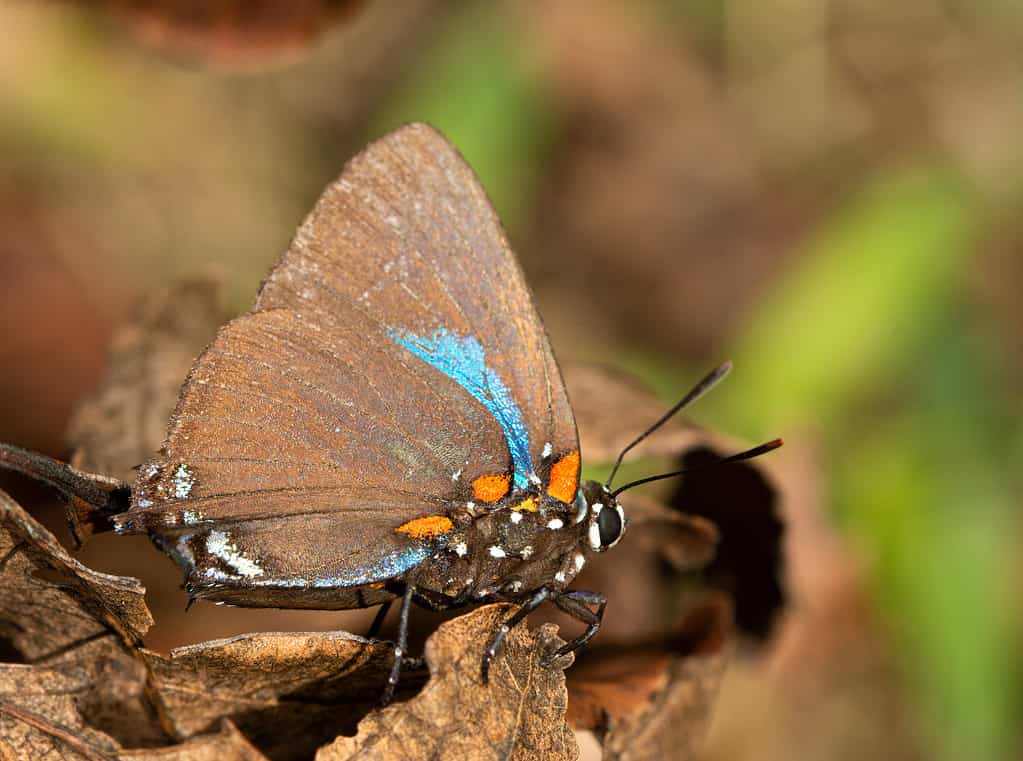
These butterflies enjoy hanging out in treetops and can be found in Florida along with other parts of the southern U.S. and scantly in Mexico.
©Sari ONeal/Shutterstock.com
The great purple hairstreak butterfly has a name you can’t forget and an appearance straight out of dreamy fantasies. They have a wingspan of up to 1.5 inches and the upper side of the male’s wings have black borders and a glistening metallic blue. The females are similar except paler with the black borders a bit broader. They also have longer double tails than males. Along with the metallic blue, their other colors include bronze and purple on the lower part of the hindwings and bright orange on their abdomens. Aside from being bolder in color, the males’ forewings have a distinctive metallic blue dash that the females don’t have. These butterflies enjoy hanging out in treetops and can be found in Florida along with other parts of the southern U.S. and scantly in Mexico.
5. Zebra Swallowtail
Scientific Name: Eurytides marcellus
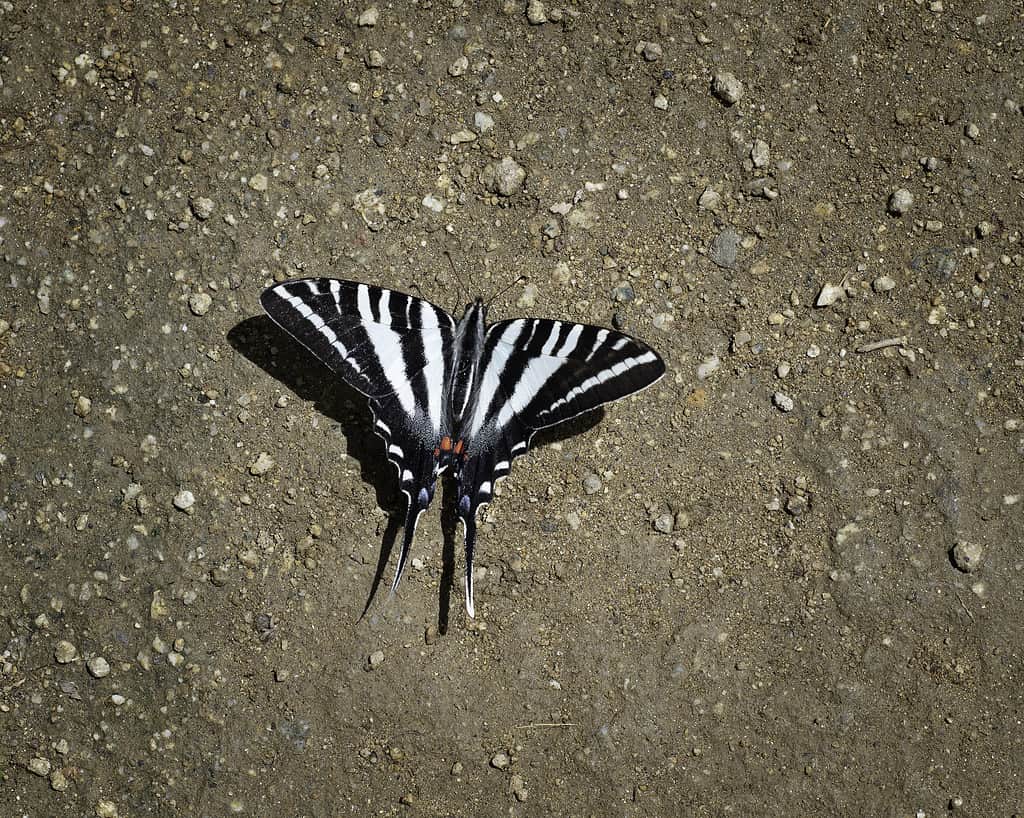
Zebra swallowtails are known for their long tails and their unique zebra-like stripes.
©iStock.com/GDMatt66
You can probably already picture what this butterfly looks like. The top of the butterfly’s wings has black stripes against a white backdrop. Zebra swallowtails also have very long tails, which helps you distinguish them. Their wingspan in adult form is up to four inches. The lower half of their wings is similar to the striped upper portion but they’re different in that they have a bright red stripe that runs through the middle. They have a triangular shape, and they change in appearance depending on the season, getting lighter and smaller with their sword-like tails also shrinking a bit in early spring. You can Zebra swallowtail butterflies that live in Florida.
6. Red-Spotted Purple
Scientific Name: Limenitis arthemis

The Red-Spotted Purple (
Limenitis arthemis) can be found in Florida and as far as Texas.
©iStock.com/Jeff Kingma
The red-spotted purple butterfly is brightly colored and enjoys wooded environments. It lives in Florida but can be found as far west as eastern Texas and it also graces northern states up to Wisconsin, New York, and New Hampshire. It has a wingspan of up to 3.5 inches. When the wings are spread, the top wings have dark colors that fade out to iridescent blue. White dashes form a trim and pops of orange decorate the trim in the form of small spots. The lower wings are even brighter, almost metallic and the white dash trim is slightly larger. The undersides of the red-spotted purple butterfly’s wings have some black and brown portions with some lighter blue areas and bigger orange spots. The white dash trim is present as well, except it’s more curved than the trim you see on the upper surface.
7. Viceroy
Scientific Name: Limenitis Archippus
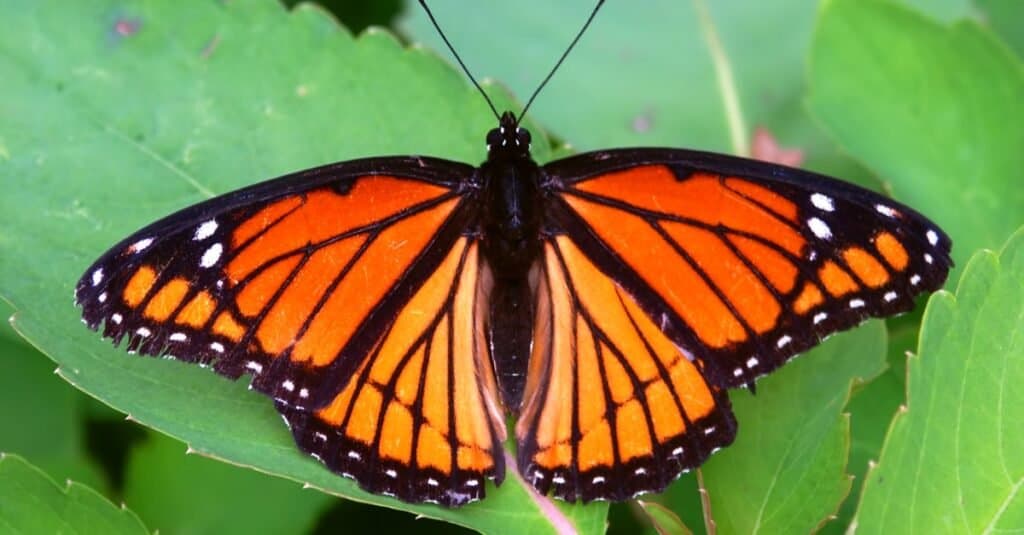
The Viceroy butterfly has a strong resemblance to the Monarch butterfly and can be found in Florida with some strays down in Cuba.
©Jason Patrick Ross/Shutterstock.com
The viceroy butterfly is strikingly similar to the monarch butterfly, only it’s smaller. These butterflies have a wingspan of up to 3 3/8 inches. They can be found east of the Sierra Nevada mountains down to the center of Mexico. The viceroy is a butterfly that lives in Florida with some strays making their way down further to Cuba. The top wings of this butterfly are black and orange and what differentiates it from the monarch butterfly is a black line that runs across its hindwing. These butterflies also have a row of white dots on the black trim on the outer edges of their wings. The underside of their wings is similar to the top, only a bit lighter.
8. White Peacock
Scientific Name: Anartia jatrophae
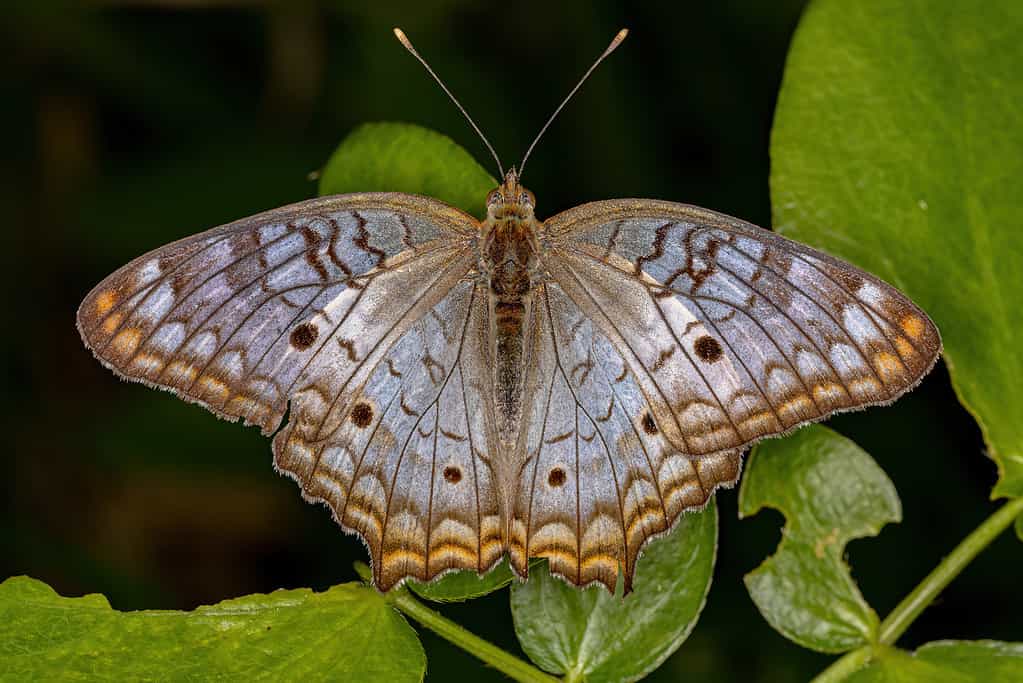
Florida is home every season to this white peacock butterfly.
©iStock.com/ViniSouza128
The white peacock butterfly calls Florida home throughout every season of the year. Their wingspan is up to 2.5 inches and the top of their wings is mostly white with some light brown markings. At the margins, there is a dual row of light-colored arcs. They also have distinctive black spots, one on each forewing and two on each hindwing. These butterflies cannot tolerate cold environments and thrive when the climate gets warmer, sometimes traveling up to the southern portion of Alabama. They make their way into gardens, fields, and even roadsides, particularly if there is water present.
9. Painted Lady
Scientific Name: Vanessa cardui

Painted lady butterflies live on nearly all continents. They enjoy open spaces like in Florida.
©Super Prin/Shutterstock.com
Painted lady butterflies have orange and brownish colorations on the top of their wings, with the forewing having a black apex patch. The leading edge has a white bar and on the hindwing, there are some black spots. The underside of this butterfly’s wings has neutral colorations, including black, brown, and gray. Their wingspan is up to 2 7/8 inches and they love open environments like old fields and gardens. They live on nearly all continents, with the exceptions of Antarctica and Australia.
10. Question Mark
Scientific Name: Polygonia interrogationis
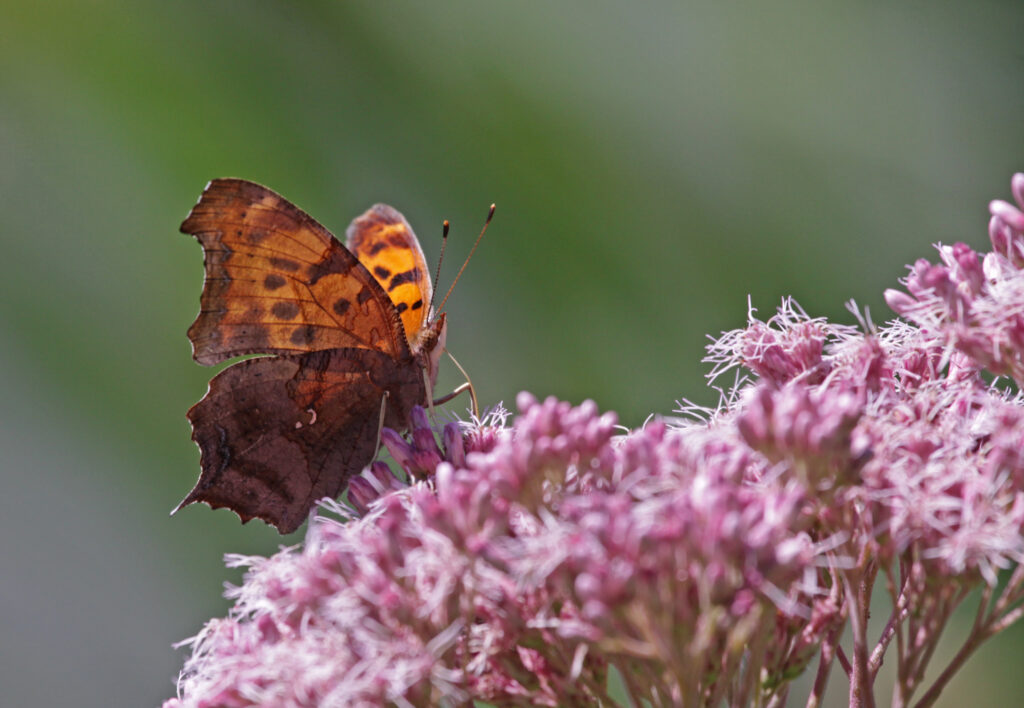
Question mark butterfly lives in Florida and prefers wooded areas near suburbs.
©Chris Hill/Shutterstock.com
This unique butterfly is medium in size and usually in wooded areas and near suburbs. It often prefers moist environments, but not always. When it folds its wings, it looks just like a dead leaf. This butterfly is among the top ten butterflies that live in Florida but also inhabit other eastern portions of the United States and Canada. Their wing span is up to 2.5 inches and they have a soft white color on their wing margins. The top of their wings has an orange coloration with dark-colored spots. The top part of their hindwing changes color depending on the season, appearing mostly black during the summer months, and lightening to an orange color during the winter months.
Thank you for reading! Have some feedback for us? Contact the AZ Animals editorial team.






